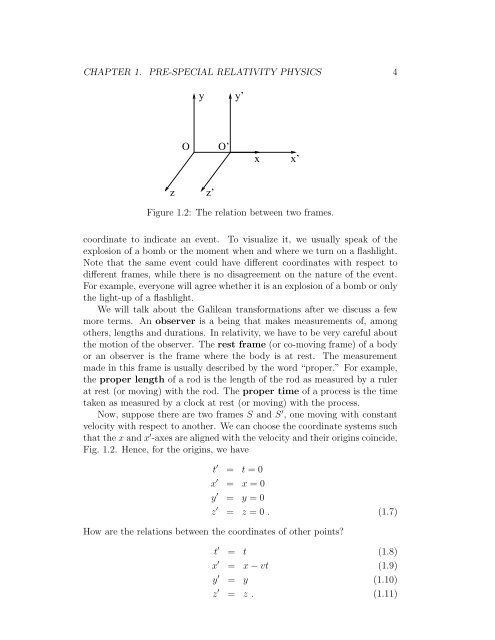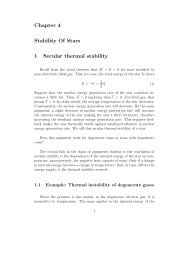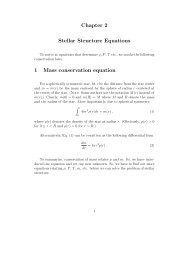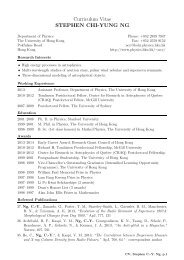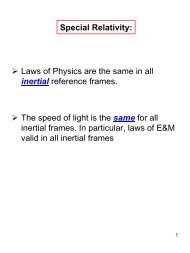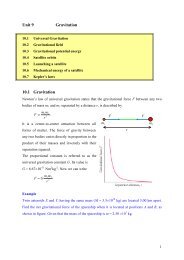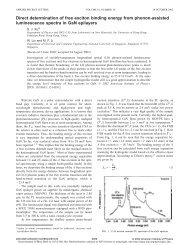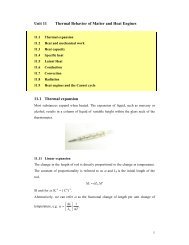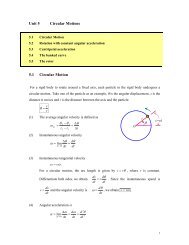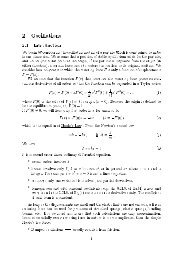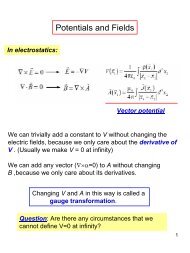here - Department of Physics, HKU
here - Department of Physics, HKU
here - Department of Physics, HKU
Create successful ePaper yourself
Turn your PDF publications into a flip-book with our unique Google optimized e-Paper software.
CHAPTER 1. PRE-SPECIAL RELATIVITY PHYSICS 4<br />
y<br />
y’<br />
O<br />
O’<br />
x<br />
x’<br />
z z’<br />
Figure 1.2: The relation between two frames.<br />
coordinate to indicate an event. To visualize it, we usually speak <strong>of</strong> the<br />
explosion <strong>of</strong> a bomb or the moment when and w<strong>here</strong> we turn on a flashlight.<br />
Note that the same event could have different coordinates with respect to<br />
different frames, while t<strong>here</strong> is no disagreement on the nature <strong>of</strong> the event.<br />
For example, everyone will agree whether it is an explosion <strong>of</strong> a bomb or only<br />
the light-up <strong>of</strong> a flashlight.<br />
We will talk about the Galilean transformations after we discuss a few<br />
more terms. An observer is a being that makes measurements <strong>of</strong>, among<br />
others, lengths and durations. In relativity, we have to be very careful about<br />
the motion <strong>of</strong> the observer. The rest frame (or co-moving frame) <strong>of</strong> a body<br />
or an observer is the frame w<strong>here</strong> the body is at rest. The measurement<br />
made in this frame is usually described by the word “proper.” For example,<br />
the proper length <strong>of</strong> a rod is the length <strong>of</strong> the rod as measured by a ruler<br />
at rest (or moving) with the rod. The proper time <strong>of</strong> a process is the time<br />
taken as measured by a clock at rest (or moving) with the process.<br />
Now, suppose t<strong>here</strong> are two frames S and S ′ , one moving with constant<br />
velocity with respect to another. We can choose the coordinate systems such<br />
that the x and x ′ -axes are aligned with the velocity and their origins coincide,<br />
Fig. 1.2. Hence, for the origins, we have<br />
t ′ = t = 0<br />
x ′ = x = 0<br />
y ′ = y = 0<br />
z ′ = z = 0 . (1.7)<br />
How are the relations between the coordinates <strong>of</strong> other points?<br />
t ′ = t (1.8)<br />
x ′ = x − vt (1.9)<br />
y ′ = y (1.10)<br />
z ′ = z . (1.11)


